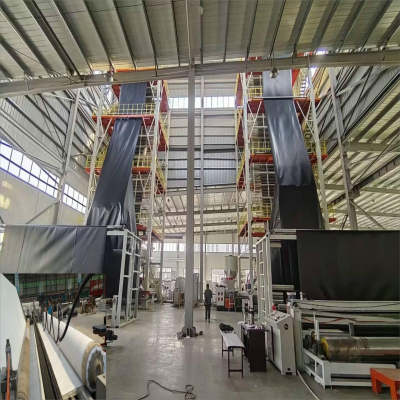Before laying geomembrane, manually level the dam slope and dam bottom, arrange the dam slope into the designed slope, and remove sharp substances. Adopt 20 cm Thick cushion of fine loam, such as blockless stones, grass roots, etc. After careful screening, the geomembrane is then laid. In order to prevent the damage to the geomembrane by freezing extrusion, 30 cm Natural river channel gravel, preventing water from flushing and protecting covering soil, laid 35 cm Thick dry masonry slope protection.
The geomembrane in the dam slope section is laid manually from top to bottom, first in the middle and then on both sides. Banners should be laid perpendicular to the dam axis, and geomembranes in the horizontal section of the slope foot should be laid manually. During the laying process, the joint surface between geomembrane and cushion must be uniform and flat to avoid damage caused by man-made and construction machinery. Do not raw pull hard pull, and do not press out dead folds, while maintaining a certain degree of relaxation to adapt to deformation due to temperature changes and other reasons. The geomembrane is cut according to the length required by the design during production by the manufacturer, and the intermediate joints are minimized when laying. Laying should be done in clear weather conditions as much as possible and laid with the gland. The composite geomembrane is arranged with an anti-slip groove in the middle of the dam slope, and the sandy loam plug is used to prevent the slip.
During the laying process of composite geomembrane, there are many splicing methods, mainly including fusion welding, bonding and so on. Fusion welding method is mainly adopted in the danger removal and reinforcement project of Alxa Zuoqi Reservoir. Geomembrane (One cloth and one film )The connection is a welding between membranes and a stitching connection between cloth. The connection construction procedure is: film laying →Solder film →Sewing base cloth →Flip-over →Sew on the cloth. After a geomembrane is laid, turn the edge to be welded Stack (Width about 60 cm),The second was laid on one film in reverse direction, and the welded edges of the two films were adjusted so that they overlapped by about 10 cm, It is beneficial to the operation of the welding machine. If the edges are uneven, they need to be trimmed, and if the film has wrinkles, they need to be leveled, so as not to affect the welding quality.
After the laying of the composite geomembrane is completed, on-site quality inspection should be carried out in time. The quality inspection method can adopt the combination of inflation method and visual inspection method, and the quality inspection subject can adopt the combination of self-inspection by the construction party and supervision inspection.
After the composite geomembrane is laid and passes the on-site quality inspection by the construction party and the supervisor, the protective layer on the membrane should be covered in time to prevent the damage of the composite geomembrane by external force or bad weather, and to prevent the aging and quality decline caused by long-term exposure of the composite geomembrane to sunlight. The upper part of the geomembrane in the slope section is first laid 10 cm Thickness of fine loam without block stones, grass roots, etc., and then lay composite geomembrane.
Post time: Jun-05-2025




